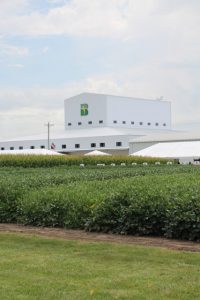PFR Practices
By Dusty Sonnenberg, CCA, Ohio Field Leader, a project of the Ohio Soybean Council and soybean check-off.
What do you need to change to raise 125 bushel soybeans? “The definition of insanity is doing what has always been done, and expecting different results,” said Travis Burnett, Field Agronomist for Becks. “The purpose of the high yield plots is to get outside our comfort zone and try different things, then work backwards with the results to see what can practically be applied to our traditional research.”
Becks has been conducting high yield corn and soybean plots for several years, utilizing the latest seed technology combined with overhead irrigation, subsurface drainage and subsurface drip irrigation. “Our challenge from Sonny Beck is to hit 125 bushels per acre,” said Burnett. “In 2020 we hit 117.”
One area which the team is trying new things to reach the goal is in how nitrogen (N) and sulfur (S) are managed in the crop. “A soybean plant uses 4-5 units of nitrogen per bushel of beans produced,” said Burnett. “That means a 60 bushel per acre soybean crop uses between 240-300 units of N per acre. Our research has indicated that the N fixed in the soil by the nodules can be sufficient for up to 90 bushels per acre.”
When supplementing N in a soybean crop, application timing is critical. “If N is applied too early, it can make the beans lazy and not produce the nodules sufficiently to fix the necessary N,” said Burnett. “The majority of N uptake by the soybean occurs from R2-R4. This happens to be the same time the N fixation in the soil is decreasing. In our high yield plot we are trying to fertigate 140 units of N from R4-R5.”
Another factor in soybean nodulation is the soil temperature. “Soil temperatures can impact soybean nodulation. Soil temperatures of 70-74 degrees are ideal,” said Burnett. “Having earlier canopy closure helps keep the soil shaded and cooler. Early canopy closure can be influenced by planting date, and plant population. Planting depth also influences nodule production. 80% of the nodules occur at the seed planting depth. Planting a little deeper also means the soil will stay a little cooler and should stay healthier to fix N.”
One of the practical findings that has been verified through the research is the influence of planting date on soybean yield. “A key to soybean yield is sunlight collection,” said Jim Schwartz, Director of PFR and Agronomy at Becks. “The sooner a soybean crop is planted, the greater the potential for early canopy and maximum sunlight collection. May is the third highest month for sunlight in the Midwest. We have seen a yield increase of 16% from earlier planting dates regardless of the planting population relative to the trial.”
Fungicide application and timing are also important factors to increasing soybean yield. “PFR research has consistently shown that the best time for soybean fungicide application is at the R3 growth stage,” said Schwartz. “60-70% of the soybean yield comes from beans on nodes 7-13. At the R3 growth stage, nodes 6-12 are present on the plant.”
Another consideration in maximizing soybean yield is row width and plant spacing. “15 inch row soybeans will out yield 30 inch row beans,” said Schwartz. “We found an increase of 3.5-4 bushels per acre by changing from 30 inch rows down to 15 inch rows. Some of this goes back to earlier canopy closure and keeping the soil cooler. Some of the increase is also attributed to better weed control. Narrower rows decrease weed pressure by having less open space for sunlight to penetrate the canopy and germinate the weeds. Research has found a 2.5% yield loss in soybeans for every leaf stage that weed control is delayed.”
While narrowing the row makes a difference, plant spacing is the key. “The reasons our PFR research favors 15 inch row beans with a planter over 7.5 inch drilled beans is overall a planter has a more accurate final population,” said Schwartz. “The planter is more consistent in planting depth. It also provides more uniform plant-to-plant spacing than the drill.”
NOTE: Becknology Days runs August 26-28th in Atlanta, Indiana.